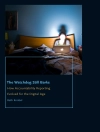This edited collection examines women journalists’ experiences and obstacles in South Africa’s (SA) democracy. They exercise power, and add a vital diversity, but they are routinely harassed in the online social media space of big tech companies such as Twitter and Facebook by populist and corrupt politicians and their supporters. Using SA as the case study, this book examines attempts to curb women journalists’ freedom combining theory and first-hand accounts. The target audience for the book includes scholars of political philosophy, gender, media, communications, NGOs, media freedom activists and journalists.
Jadual kandungan
Chapter one: Introduction.- Chapter two: The Triple Oppressions: race, class and gender in South African journalism.- Chapter three: Reporting sexual and gender-based violence: A decolonial gaze on women journalists in South Africa.- Chapter four: Glass Ceilings: cybermisogyny is a sign of unchecked sexism in media and newsrooms.- Chapter five: The Hounding.- Chapter six: Threats to rape and kill me.- Chapter seven: Building media credibility and ethics in South Africa: A way forward from the margins.- Chapter eight: The gender pay gap in the South African media sector.- Chapter nine: The marginalisation of Women’s voices in news stories – thoughts on a way forward.- Chapter ten: Reflections: Re-imagining journalism for a feminist future.
Mengenai Pengarang
Glenda Daniels is Associate Professor in Media Studies at the University of the Witwatersrand, SA. She is author of Power and Loss in South African Journalism: news in the age of social media (2020); Fight for Democracy: the ANC and media in South Africa (2012) and co-author of Glass Ceilings: women in South African Media Houses, 2018 (2018).
Kate Skinner is Executive Director of the Association for Independent Publishers, SA. She has been a media freedom activist, researcher and policy analyst for the last 25 years and has worked in the unions, NGOs, government and the media industry to build a diverse, independent media sector.












